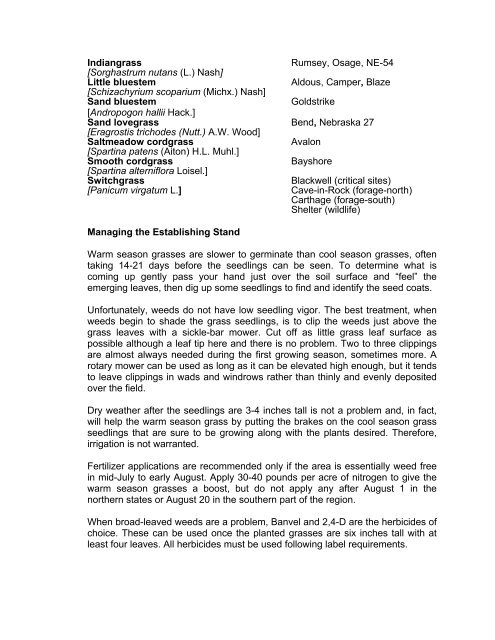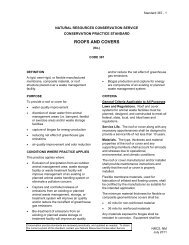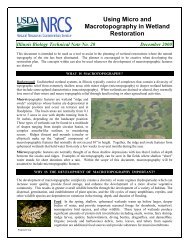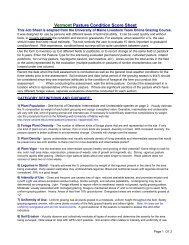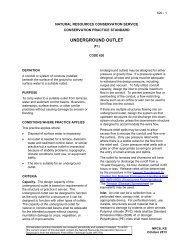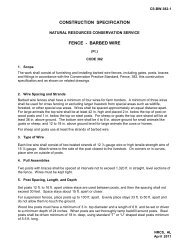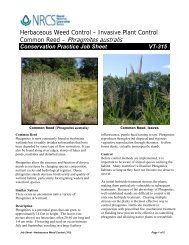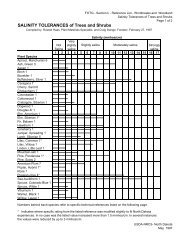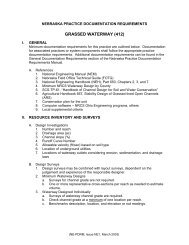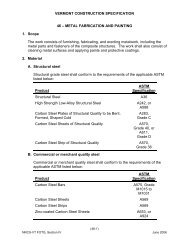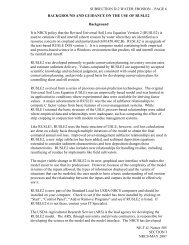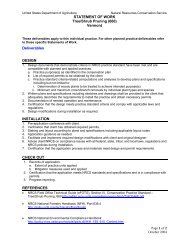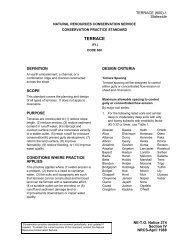The Use of Native Warm Season Grasses for Critical Area Stabilization
The Use of Native Warm Season Grasses for Critical Area Stabilization
The Use of Native Warm Season Grasses for Critical Area Stabilization
Create successful ePaper yourself
Turn your PDF publications into a flip-book with our unique Google optimized e-Paper software.
IndiangrassRumsey, Osage, NE-54[Sorghastrum nutans (L.) Nash]Little bluestemAldous, Camper, Blaze[Schizachyrium scoparium (Michx.) Nash]Sand bluestemGoldstrike[Andropogon hallii Hack.]Sand lovegrass Bend, Nebraska 27[Eragrostis trichodes (Nutt.) A.W. Wood]Saltmeadow cordgrassAvalon[Spartina patens (Aiton) H.L. Muhl.]Smooth cordgrassBayshore[Spartina alterniflora Loisel.]SwitchgrassBlackwell (critical sites)[Panicum virgatum L.]Cave-in-Rock (<strong>for</strong>age-north)Carthage (<strong>for</strong>age-south)Shelter (wildlife)Managing the Establishing Stand<strong>Warm</strong> season grasses are slower to germinate than cool season grasses, <strong>of</strong>tentaking 14-21 days be<strong>for</strong>e the seedlings can be seen. To determine what iscoming up gently pass your hand just over the soil surface and “feel” theemerging leaves, then dig up some seedlings to find and identify the seed coats.Un<strong>for</strong>tunately, weeds do not have low seedling vigor. <strong>The</strong> best treatment, whenweeds begin to shade the grass seedlings, is to clip the weeds just above thegrass leaves with a sickle-bar mower. Cut <strong>of</strong>f as little grass leaf surface aspossible although a leaf tip here and there is no problem. Two to three clippingsare almost always needed during the first growing season, sometimes more. Arotary mower can be used as long as it can be elevated high enough, but it tendsto leave clippings in wads and windrows rather than thinly and evenly depositedover the field.Dry weather after the seedlings are 3-4 inches tall is not a problem and, in fact,will help the warm season grass by putting the brakes on the cool season grassseedlings that are sure to be growing along with the plants desired. <strong>The</strong>re<strong>for</strong>e,irrigation is not warranted.Fertilizer applications are recommended only if the area is essentially weed freein mid-July to early August. Apply 30-40 pounds per acre <strong>of</strong> nitrogen to give thewarm season grasses a boost, but do not apply any after August 1 in thenorthern states or August 20 in the southern part <strong>of</strong> the region.When broad-leaved weeds are a problem, Banvel and 2,4-D are the herbicides <strong>of</strong>choice. <strong>The</strong>se can be used once the planted grasses are six inches tall with atleast four leaves. All herbicides must be used following label requirements.


